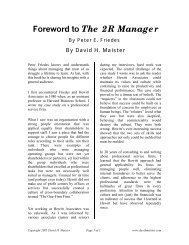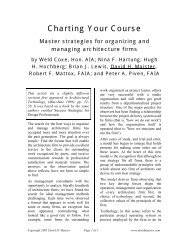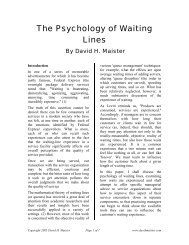pdf version - David Maister
pdf version - David Maister
pdf version - David Maister
Create successful ePaper yourself
Turn your PDF publications into a flip-book with our unique Google optimized e-Paper software.
Results and Rewards in The<br />
Multi-Group Firm<br />
By <strong>David</strong> H. <strong>Maister</strong><br />
This article first appeared in the<br />
September 1994 Supplement to<br />
International Law Firm Management. A<br />
revised <strong>version</strong> appeared in First Among<br />
Equals (2002) by McKenna and <strong>Maister</strong>.<br />
Among professional firms there exists a<br />
wide array of systems for measuring and<br />
rewarding partners who operate in<br />
different locations or different practice<br />
groups.<br />
At one extreme, some firms operate their<br />
separate locations or practice groups as<br />
distinct profit centers with minimal<br />
sharing of profits.<br />
At the other extreme are firms who try to<br />
avoid creating intergroup competition by<br />
treating office or group results as<br />
irrelevant. Some avoid even calculating<br />
office and group results for this reason.<br />
The vast majority of firms operate<br />
between these two extremes. The results<br />
of the group to which the partner<br />
belongs are usually treated as an<br />
influence (or a contributing factor) in<br />
assessing performance and awarding<br />
compensation, but they are rarely<br />
determinative.<br />
It is a difficult juggling act to examine<br />
group results without giving off the<br />
dysfunctional signal that only local<br />
group results are important, thereby<br />
destroying intergroup cooperation.<br />
However, I believe that it can be done<br />
and that it is important to examine group<br />
results, whether groups are defined by<br />
location, discipline or industry. (It is<br />
wise to examine the results of all three<br />
types of groups.)<br />
Without such analysis intergroup<br />
cooperation is hard to encourage, and a<br />
firm must understand its economics at<br />
levels below that of the whole firm.<br />
Most firms attempt to deal with this<br />
problem by avoiding a short-term (year<br />
by year), formulaic approach to group<br />
results, and take a longer-term, more<br />
“judgmental” approach. There is rarely a<br />
strict formula saying that local group<br />
results have the following weighting in<br />
rewards.<br />
On the other hand, most firms recognize<br />
that no group can be treated as either a<br />
“cash cow” or a “permanent sink” for an<br />
extended period of time.<br />
With varying degrees of formality, most<br />
firms will ensure that over a three-to-five<br />
yearCC period, for instance, the<br />
compensation awarded to the partners in<br />
a group are commensurate with the<br />
profits earned in that group.<br />
To monitor this, many firms explicitly<br />
use and compare three- or five-year<br />
averages of aggregate compensation and<br />
performance in each group. However,<br />
these three-year averages will still only<br />
be used as guidelines, as a check on the<br />
system but not as a strict formula.<br />
Copyright 2005 <strong>David</strong> H. <strong>Maister</strong> Page 1 of 1 www.davidmaister.com
Results and Rewards in The Multi-Group Firm<br />
In addition, firms need to be<br />
conscientious in demonstrating that a<br />
star partner in an unprofitable office can<br />
be rewarded like a star, while an<br />
underperforming partner in a stellar<br />
office does not get a free ride.<br />
Measuring ResultsC<br />
If local office or group results are to be<br />
considered, the question arises as to how<br />
these should be measured. The answer is<br />
not as obvious as it might appear.<br />
First, there exists the issue of developing<br />
a “balanced scorecard” that tracks not<br />
only financial results but also the other<br />
goals that any professional group needs<br />
to achieve to be deemed a success.<br />
Included in such a balanced scorecard<br />
would be measures of client satisfaction,<br />
the group’s ability to develop its people,<br />
its contribution to firmwide assets such<br />
as shared tools and research, and the<br />
group’s contributions to firmwide<br />
success.<br />
Few if any firms have a balanced<br />
scorecard organized in a formal way,<br />
although most claim to make judgmental<br />
assessments of these factors.<br />
Even on the financial front, much<br />
confusion exists. At this point most<br />
firms have progressed to using “profit<br />
per partner” (or “profit per officer” in<br />
firms that are not partnerships) as a<br />
measure of practice group success,<br />
although even this is not always a clear<br />
guide to which groups have performed<br />
well and which have not. (To see this,<br />
consider Figure 1.)<br />
What this reveals is that profit per<br />
officer is the simple multiplication of<br />
four key submeasures: margin, rate,<br />
utilization (also referred to as<br />
chargeability or billability) and leverage.<br />
Two of these four factors are what I term<br />
“hygiene” issues, while two others<br />
reflect changes in fundamental profit<br />
“health.” The two hygiene factors are<br />
margin and utilization, while the two<br />
health factors are rate and margin.<br />
To understand the difference between<br />
these categories, consider (as an<br />
illustration) two of the four ways of<br />
improving profit per officer: increasing<br />
utilization or increasing rate. One group<br />
may have improved its profitability by<br />
working more hours per person. Another<br />
may have achieved exactly the same<br />
profit improvement by working the same<br />
number of hours per person as the<br />
previous year but by raising its rate per<br />
hour through some combination of client<br />
service, specialization, innovation or the<br />
bringing in of higher-rate transactions.<br />
These two groups may have achieved the<br />
same profit per officer improvements but<br />
their accomplishments are not<br />
commensurate. Increasing utilization (or<br />
hours worked) means you made more<br />
money because you worked harder.<br />
It is a nontrivial accomplishment, but it<br />
is primarily a short-term achievement. I<br />
call it the donkey strategy—achieving<br />
more by pulling a heavier load.<br />
However, a group that made more<br />
money, not by working harder but by<br />
getting the market to place a higher<br />
value on each hour worked, has<br />
accomplished something much more<br />
profound and longer lasting by definition<br />
because they have made themselves<br />
more valuable in the marketplace.<br />
The same argument can be made for the<br />
difference between margin and leverage.<br />
Improving margin is (mostly) about<br />
controlling overhead expenses—<br />
important, but nevertheless hygiene. But<br />
a group that finds a way to deliver its<br />
Copyright 2005 <strong>David</strong> H. <strong>Maister</strong> Page 2 of 2 www.davidmaister.com
Results and Rewards in The Multi-Group Firm<br />
services with less senior and more junior<br />
partner time must, by definition, have<br />
built an asset: It has found a way to get<br />
work done by using lower-cost people.<br />
To have leveraged successfully, it must<br />
have found new ways to deliver its<br />
services, to train and manage people to<br />
handle what they could not before and to<br />
establish new methodologies.<br />
To show how these categories can be<br />
used, examine Figure 2, which shows the<br />
financial results for a firm of six<br />
(fictional) groups.<br />
It can be seen that all offices improved<br />
their profitability but in very differing<br />
ways. It is even easier to see what<br />
happens if all results for each office are<br />
expressed as a percentage of the<br />
respective firmwide averages, as is done<br />
in Figure 3.<br />
For example, it is clear that Group 1,<br />
with the highest firmwide profit per<br />
officer, achieves this result almost<br />
entirely by being in a high-fee-level<br />
market, with none of its other<br />
performance measures being particularly<br />
noteworthy. Are the officers to be<br />
rewarded for good performance or does<br />
this reflect good fortune and good<br />
location?<br />
Group 2 shows good overall results, but<br />
these are achieved mostly through<br />
hygiene factors of chargeability<br />
(utilization) and margin control. Neither<br />
is strong, although leverage improved a<br />
little in the latest year.<br />
A final productive way of summarizing<br />
and presenting this information is to<br />
calculate a Hygiene Index (multiply the<br />
margin index by the utilization index)<br />
and a Health Index (multiply the rate<br />
index by the leverage index). This is<br />
done in Figure 4.<br />
It is now easier to see what has happened<br />
in each office. Group 1 has increased its<br />
profitability by pushing even further on<br />
its fundamental health, but its hygiene<br />
continues to deteriorate relative to the<br />
rest of the firm. It may be the most<br />
profitable office but clear guidance for<br />
further improvement could be given.<br />
Group 2 has done a good job of<br />
improving its profit health and should be<br />
commended. Group 3, while it improved<br />
its cash profit per partner, has slipped<br />
relative to the rest of the firm and in<br />
particular has let its profit health decline<br />
badly.<br />
Group 4 has done a good job of profit<br />
health but lost its superior position in<br />
hygiene; it still has work to do.<br />
Group 5 has the opposite (and a much<br />
worse) problem. It has fixed a hygiene<br />
problem but at the expense of dealing<br />
with profit health. While it, too,<br />
improved its cash profit per partner (up<br />
from $276.5K to $305.6K), it still has<br />
problems.<br />
Group 6 has made little progress.<br />
Hopefully it is clear that analyses such<br />
as these will give much more guidance<br />
to a management committee when<br />
appraising the performance of an<br />
operating group than would a simple<br />
comparison of profit per partner figures.<br />
Earnings Per Share<br />
When it comes time to turn performance<br />
evaluation into reward setting, even the<br />
powerful measure of profit per officer<br />
has its limits. Its biggest problem is that<br />
it relates profits to the number of officers<br />
(head count) while it makes no<br />
distinction regarding a group of younger<br />
partners from whom there might<br />
(appropriately) be lower profit<br />
expectations.<br />
Copyright 2005 <strong>David</strong> H. <strong>Maister</strong> Page 3 of 3 www.davidmaister.com
Results and Rewards in The Multi-Group Firm<br />
Similarly, a high profit per officer does<br />
not necessarily mean that a group<br />
deserves an increase in compensation (or<br />
share of the profits). It might well be the<br />
case that the partners in a high-profitper-partner<br />
group are already fully<br />
compensated for their high levels of<br />
profit and that a low-profit-per-partner<br />
group is staffed with low income<br />
partners who do not deserve to be<br />
reduced.<br />
As a number of firms have discovered,<br />
there is a simple ratio that overcomes<br />
these issues—the use of an earnings per<br />
share (EPS) ratio. Here, share refers<br />
simply to the share of firm profits held<br />
by the partners in the office or group.<br />
Some firms have a “unit” system for<br />
dividing partnership profits, with each<br />
partner holding a certain number of units<br />
and each unit representing a fixed<br />
percentage claim on the firm’s profits. In<br />
such a case, one would calculate the<br />
earnings per unit of the group (EPU).<br />
Other firms do not use the term “units”<br />
but allocate percentage points, which is<br />
effectively the same thing. If a partner<br />
has a claim to 3.6 percent of the firm’s<br />
profits, then he or she can be said to hold<br />
3.6 units out of a total of 100 units.<br />
Under any of these systems, the EPS<br />
ratio can be calculated by dividing the<br />
profits of each group by the sum total of<br />
units, percentage points or even cash<br />
compensation held by the partners in the<br />
group. (Any one of these approaches<br />
will work as long as it is consistently<br />
applied.)<br />
The virtue of the EPS ratio is that it<br />
gives an immediate guide to which<br />
groups are candidates for increased<br />
profit allocation and which are<br />
candidates for reductions. Consider a<br />
group that on a three-year average basis<br />
has sustained a high EPS. By definition,<br />
this group has high earnings (profits)<br />
relative to the number of profit shares<br />
allocated to the partners in that group. A<br />
greater profit-share allocation might be<br />
in order.<br />
Similarly, any office with a low EPS<br />
(particularly if this is a three-year<br />
average) would have earnings that are<br />
low relative to the aggregate profit<br />
shares held by the partners in the group.<br />
In such a situation a (relative) share<br />
reduction might be called for.<br />
Of course, there are other action<br />
possibilities. Perhaps the firm has<br />
partners in that group who are too high<br />
powered to be working there (relative to<br />
the earning potential in that market), and<br />
they might better serve the firm by being<br />
deployed to better markets.<br />
A third possible action is to conclude<br />
that the low EPS is the result of a<br />
conscious strategic decision to invest<br />
“expensive” partner resources in a<br />
market that the firm is trying to nurture.<br />
Whatever the conclusion, the EPS ratio<br />
provides a convenient way to relate<br />
profitability to the set of decisions about<br />
where the firm’s “equity” should be<br />
located. Just as in industry, EPS is a<br />
measure of return on equity investment<br />
and provides guidance as to whether the<br />
firm is placing its valuable resources in<br />
the correct markets.<br />
As we noted above, no approach to<br />
partner reward should be formulaic and<br />
none should be conducted on a singleyear<br />
basis. However, a three-year<br />
average of EPS for each office and<br />
practice group, together with the use of<br />
the Health and Hygiene Indexes, will<br />
give a firm a good basis for discussion of<br />
how well it is matching results and<br />
rewards in a multigroup environment.<br />
Copyright 2005 <strong>David</strong> H. <strong>Maister</strong> Page 4 of 4 www.davidmaister.com
Results and Rewards in The Multi-Group Firm<br />
<strong>David</strong> <strong>Maister</strong> is the author of Managing<br />
the Professional Service Firm (1993),<br />
True Professionalism (1997), The<br />
Trusted Advisor (2000) (coauthor),<br />
Practice What You Preach (2001) and<br />
First Among Equals (2002) (coauthor.)<br />
Prior to launching his (solo but global)<br />
consulting practice in 1985, he served as<br />
a professor at the Harvard Business<br />
School.<br />
TEL: 1-617-262-5968<br />
E-MAIL:<br />
HTUdavid@davidmaister.comUTH<br />
WEBSITE:<br />
HTUwww.davidmaister.comUTH<br />
You can automatically receive <strong>David</strong>’s<br />
future articles via e-mail (at no cost) by<br />
registering on his web site<br />
(HTUwww.davidmaister.comUTH).<br />
See Graphs on pages that follow.<br />
Copyright 2005 <strong>David</strong> H. <strong>Maister</strong> Page 5 of 5 www.davidmaister.com
B=B<br />
BXB<br />
U BXB<br />
Results and Rewards in The Multi-Group Firm<br />
Figure 1<br />
UPROFITS U<br />
OFFICERS<br />
UPROFITSU<br />
FEES<br />
UFEES<br />
HOURS<br />
UHOURS UB<br />
PEOPLE XB<br />
UPEOPLE<br />
OFFICERS<br />
= MARGIN X RATE X UTILIZATION X LEVERAGE<br />
Figure 2<br />
Last Year<br />
This Year<br />
Margin Rate Utilization Leverage PPO* Margin Rate Utilization Leverage PPO*<br />
0.318 $190.8 1425 4.3 $371.8K Group 1 0.299 $186.6 1503 4.6 $385.7K<br />
0.390 $115.2 1710 4.6 $353.4K Group 2 0.387 $117.1 1720 4.9 $381.9K<br />
0.413 $127.2 1500 4.5 $354.6K Group 3 0.414 $128.1 1612 4.2 $359.1K<br />
0.398 $ 91.2 1725 4.7 $294.3K Group 4 0.425 $103.7 1472 4.8 $311.4K<br />
0.356 $121.2 1335 4.8 $276.5K Group 5 0.368 $117.1 1612 4.4 $305.6K<br />
0.375 $112.8 1740 3.2 $235.5K Group 6 0.341 $115.3 1658 3.9 $254.2K<br />
0.377 $122.7 1560 4.5 $314.3K FIRM AVG0.379 $124.3 1599 4.5 $334.5K<br />
* PPO= profit per officer<br />
Figure 3: Results Expressed as an Index of Firm Averages<br />
Last Year<br />
This Year<br />
Margin Rate Utilization Leverage PPO<br />
Margin Rate Utilization Leverage PPO<br />
84 155 91 96 118 Group 1 79 150 94 102 115<br />
104 94 110 103 112 Group 2 102 94 108 108 114<br />
110 104 96 101 113 Group 3 109 103 101 93 107<br />
106 74 111 105 94 Group 4 112 83 92 106 93<br />
95 99 86 107 88 Group 5 97 94 101 97 91<br />
100 92 112 71 75 Group 6 90 93 104 86 76<br />
Copyright 2005 <strong>David</strong> H. <strong>Maister</strong> Page 6 of 6 www.davidmaister.com
Results and Rewards in The Multi-Group Firm<br />
100 100 100 100 100 FIRM AV100 100 100 100 100<br />
Figure 4: Health and Hygiene<br />
Last Year<br />
This Year<br />
Hygiene Index Health Index PPP Index Hygiene Index Health Index PPP Index<br />
77 149 118 Group 1 74 153 115<br />
113 96 112 Group 2 110 102 114<br />
105 104 113 Group 3 110 96 107<br />
117 78 94 Group 4 103 92 91<br />
81 106 88 Group 5 98 92 91<br />
111 66 75 Group 6 93 80 76<br />
Copyright 2005 <strong>David</strong> H. <strong>Maister</strong> Page 7 of 7 www.davidmaister.com











